Email Marketing
What techniques make your email campaign relevant?
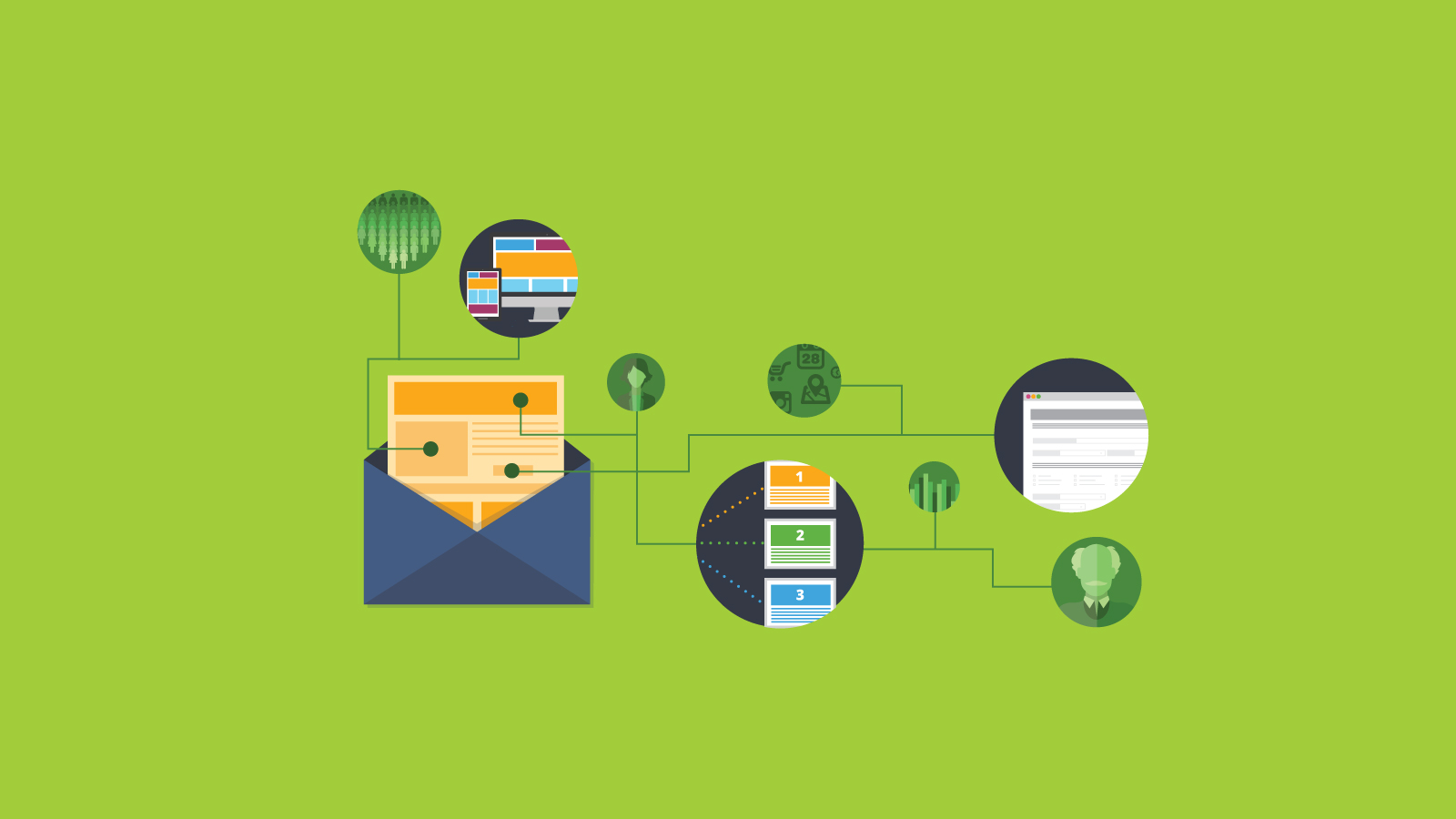
Email Marketing

Relevant emails drive 18x more revenue than broadcast emails. However, what is relevant to one of your readers could be inconsequential to another. That’s because individual’s needs and wants differ from one person to the other, so how do you create email that’s relevant to your whole audience, not just a niche group within it?
In this blog we’ll break down what strategies, technology and best practices you need to employ to ensure relevancy in your email campaigns across the board.
First things first, start by crafting a compelling subject line. With 93 billion marketing emails being sent each day, the battle for attention in the inbox is real. In fact, approximately 35% of email recipients report that they open an email based on subject line alone. That means that over a third of your subscribers are judging your emails solely on the subject line. If you want open rates to go up, your subject lines have to be strong, eye-catching, and enticing.
In order to craft a subject line that will have some kick to it, you need to be able to put yourself in your readers’ shoes. Your readers are getting flooded with SPAM on a daily basis and sometimes don’t have the time to separate the wheat from the chaff. That’s why you, as a marketer, need to stay away from ambiguous teasers and tongue-in-cheek titles.
A case study conducted by AWeber Communications found that a clear subject line gets 541% more clicks than one that’s clever. Clarity is essential to your open rates. Take a tip from MailChimp when they say, “When it comes to email marketing, the best subject lines tell what’s inside, and the worst subject lines sell what’s inside.”
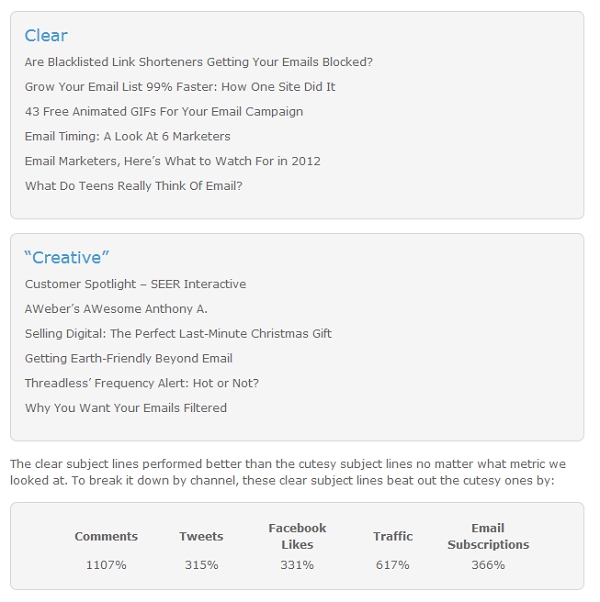
Another thing you want to steer away from when writing your subject line is using click-bait in your opener. A Return Path study of more than 9 million emails found that emails with clickbait-like words in the subject line had lower read rates compared to emails with similar content that avoided clickbait words.
For example, the use of “Secret of” resulted in an 8.69% decrease in read rates compared to messages containing similar content sent under different subject lines. The word “shocking” accompanied a 1.22% decrease in read rates as well.
Check out the graph below breaking down clickbait keywords to avoid:
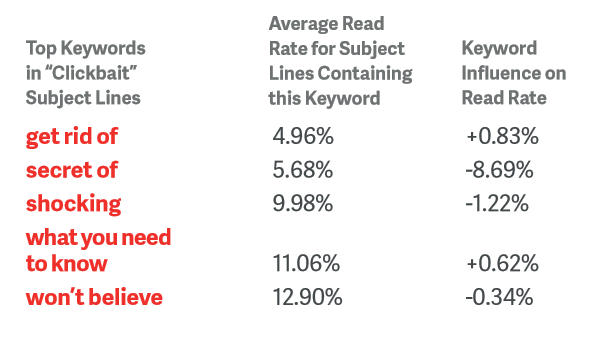
Besides underperforming, clickbait subject lines also destroy the trust between you and your new lead. Even if this tactic feels like an easy way to get an open, remember that it may just as easily result in an unsubscribe.
Now that you know to avoid clever subject lines or using click bait, check out these 5 tips to create compelling subject lines to get your creative juices flowing.
“Having trouble viewing this email? Click here to view it in a web browser.” No doubt you’ve seen this phrase at the top of hundreds, if not thousands of email messages. But you don’t want this to be the first thing your audience reads after your subject line.
Preheader text allows you an average of 50-100 characters to use in conjunction with your subject line to convince someone to open your email. So, make the most of it!
Need some guidance on how to make a preheader that really packs a punch? Here are 5 strategies to make your preheader more effective:
The preheader text in the example below makes great use of subject line elaboration.
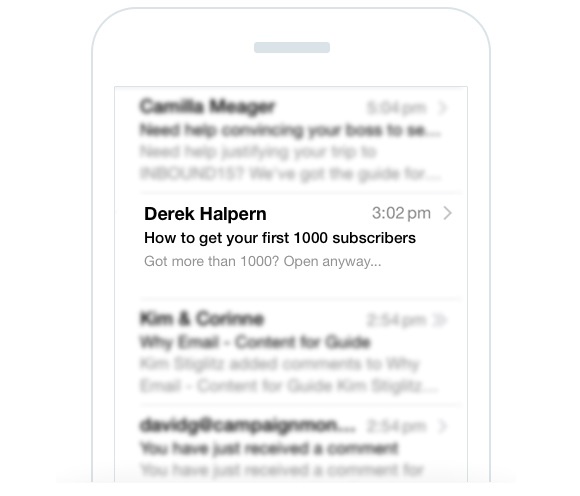
Need help coding your preheader in your email after you’ve come up with an engaging opener? Grab these tips to code fantastic preheaders in your next campaign!
If you are going to successfully convert new subscribers from your emails, you can’t just blast ‘em with general, impersonalized content. Your audience wants relevant information and the way you can ensure you’re speaking to the individual is by using list segmentation when you deploy campaigns. With the proper analytics and reporting in place, you can segment your list by simple things like gender, all the way down to more granular characteristics like geolocation, subscriber level reporting, the device they are using to read the email and so much more!
Not sure just separating your list by subscriber behavior or particular demographics will have an impact? Lyris found that 39% of marketers who segmented their email lists experienced higher open rates, 28% experienced lower unsubscribe rates, and 24% experienced better deliverability and greater revenue.
If you check out the graph below, you will see that there are TONS more reasons to leverage this tactic, including greater relevance.
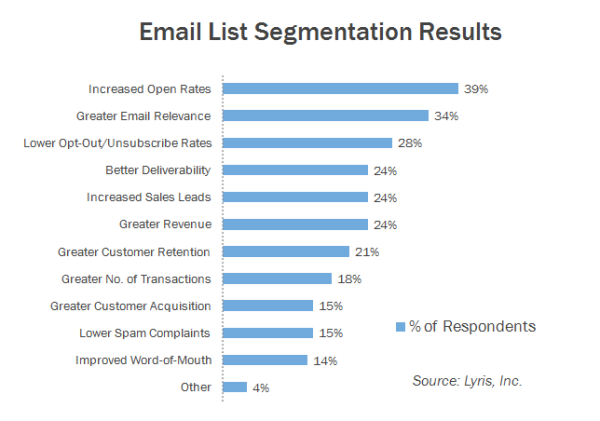
The complexity and degree to which a marketer can segment a list vary greatly. For the beginners out there, don’t overcomplicate your segmenting strategy. Start small by pulling the basic demographics that you collected when they opted-in, such as age, gender, company position, etc.
Other ways you can segment your mailings to maximize ROI is by segmenting by geolocation, sending frequency, where someone is at in the purchase cycle, digital behavior, past purchases or abandoned carts, and email activity like clicks and opens.
Kate Spade does an awesome job in the email below by segmenting and deploying a campaign based on digital behavior. Digital behavior, for example, can be tracked by seeing which pages of yours they visited, how long they stayed on your website and how you obtained their email. The average shopping cart abandonment rate is approximately 67%, so Kate Spade was smart to trigger a card abandonment email 24 hours after they left the shopping cart.
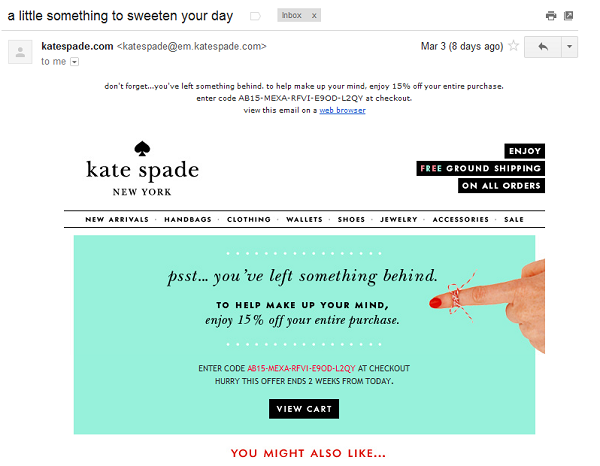
The possibilities are endless for how you can slice or dice your data to create more relevant email.
The downside of list segmentation though is that you can segment your list based on reader characteristics 100x over, but when it comes to campaign deployment, you then have to manually create and deploy multiple creatives/campaigns based on each segmented list. This is where dynamic content comes into play to create engaging email.
You need dynamic content in your emails. Why? Because consumers want more relevance. For example, 56% of people unsubscribe due to irrelevant content and dynamic software will keep your customers engaged and make your business more competitive.
Dynamic content enables you to send highly targeted email campaigns to your subscribers by automatically showing different content for different recipients. That way, you don’t have to create several versions of a campaign, instead you just press send once!
There are many different types of dynamic content in email, running the gamut from old school (yet still effective) first name personalization to cutting-edge customization with context-based content or predictively personalized content recommendations.
A great piece of data you can use to create dynamic email is one’s geolocation. Capturing your subscriber’s geographic location is as easy as asking for their zip code when they opt in. By knowing where your contacts live you can localize subject lines, deploy emails based on their time zones and only send location-specific emails to those readers.
S-Digital took geolocation to the next level with dynamic maps in their campaign for the Open Golf Championship. The example below uses geolocation and routing services to create dedicated travel directions (to the Championships) for each and every recipient of the campaign!

As a result of the campaign, the online traffic increased by 250% with over 500 leads!
Need more examples of how to use dynamic software in email effectively? Check out our blog on the 10 Best Ways to Use Dynamic Content in Email for more inspiration.
Relevancy drives individuals to engage in email campaigns. In fact, Ascend2 reports the following to be the most effective tactics to achieve email marketing objectives:

Since marketers aren’t in the business of mind reading, one easy way to ensure you are delivering relevant information is to allow readers to self-segment. That is where email preference centers come in.
An email preference center provides an easy way for your subscribers to manage their email by giving them a centralized portal to control what they receive and how often they receive your messages.
ExactTarget’s “The Social Break-Up” report found that the top reasons people unsubscribe from emails are frequency, interest, and volume. With an email preference center, you can alleviate these top 3 reasons your readers bail.
Bonobos did a great job regarding sending frequency by incorporating the preference center in the opt-out process below.
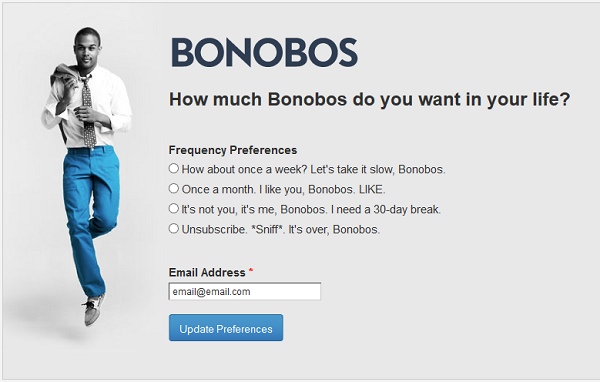
Do you have multiple email lists? Tons of different products? Let your users tell you what they want to hear about through your preference center.
J. Crew let readers choose what future mailings would be the most relevant to them in the opt-out process, while still providing the option to unsubscribe completely.
This seems like a painfully obvious element, but I see underwhelming offers daily. We are bombarded by digital advertising on a daily basis so if you want to stand out from the crowd, ensure you are offering something relevant, useful and valuable. If you offer something of value right away, this will help you differentiate yourself from your competitors and put you front of mind. Also, giving before getting builds trust with your audience instead of just hitting them over the head with a sales pitch.
CookSmarts’s email below is a great example of providing a wealth of helpful tips and tricks to cooking fanatics. They offer a slew of fantastic recipes to try out as well as a cooking schedule to keep you on the healthy track!
There are tons of different offers you can give to reel in your audience and set up a quid pro quo. You can accomplish this by offering a special report, a whitepaper or a downloadable template. If you’re farther down the nurturing sequence with your prospects and the goal is a sale, you could offer coupons, a discount or a bundle of features if they buy before a certain deadline.
61% of consumers read at least some emails on a mobile device, and 30% read email on their mobile device exclusively (Yesmail “Email Compass”). On top of that, as many as 70 percent of smartphone users say that they will delete emails immediately if they do not render properly on their device. That’s why you must ensure your mobile audience has an amazing experience interacting with your campaign.
Whether it’s your first email to a new lead or an email you’re sending to your client of five years, sending a broken email can be devastating to your ROI.
And don’t fool yourself into believing that popping off a quick test to your iPhone or Gmail inbox will do the job; it won’t. That’s because every email client’s rendering engine is NOT created equal.
Almost every email client displays HTML differently because each client has its own unique way of interpreting your HTML. That is why your HTML code can get all messed up in some email clients like Outlook even though that very same code looks like pixel perfection in another inbox.
Below is proof that even bigwigs like Google sometimes fail to properly test their email, and the results can be ugly.

Expedia, unlike the email above, shows how your email can look fabulous across clients and devices.
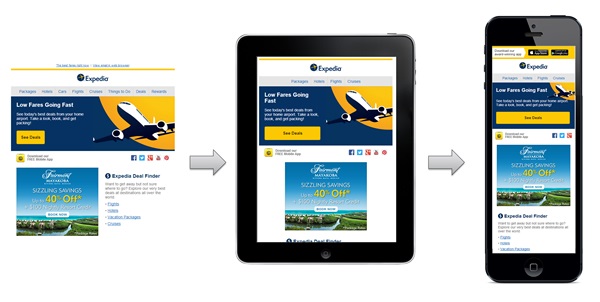
The best mobile experiences in email are created with the use of responsive or fluid hybrid templates. If your email service provider does not already offer these types of templates, we have a free fluid hybrid template with your name on it!
We’ve also got an entire blog post dedicated to mobile optimization. Once you have customized and optimized a template that should look good across clients, platforms and devices, test it to make sure that it does.
Did we miss any strategies that you employ to send hyper-targeted and tailored messages to your readers? If so, comment below as we’d love to hear how you speak to the individual, and not the crowd in your campaigns.